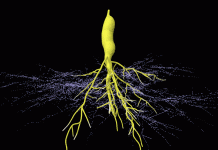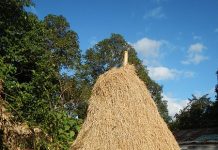Jim Lane
![Cereslgo[1].jpg](http://www.altenergystocks.com/wp-content/uploads/2017/08/Cereslgo_1_.jpg) Newly-public Ceres (CERE) makes major breakthrough on miscanthus; is the gigantic energy grass ready for prime-time? Why is miscanthus driving so much attention, yet deserving more?
Newly-public Ceres (CERE) makes major breakthrough on miscanthus; is the gigantic energy grass ready for prime-time? Why is miscanthus driving so much attention, yet deserving more?
In California, followers of NASDAQ prices noted yesterday that shares in the newly-public Ceres (CERE) rocketed up 15 percent to close at $17.52. What happened? It was revealed yesterday, in the peer-reviewed, online journal PLoS One that Ceres and the Institute of Biological, Environmental and Rural Sciences (IBERS) at Aberystwyth University in Wales have completed the first high-resolution, comprehensive genetic map of miscanthus. The full article is here.
In other crops, this type of comprehensive genetic mapping has significantly shortened product development timelines. Hence, the lift in the stock.
Proving that money is not, as it turns out, the root of all evil. Apparently, it can drive the attention of NASDAQ investors away from the dramatics of The Kardashians or NCAA basketball and towards the frontiers of science, in ways that ruler-slapping, ninth-grade biology teachers can only dream of.
The breakthrough in miscanthus
As published in the journal article, Ceres researchers mapped all 19 chromosomes of miscanthus, a towering cane-like grass that can be used as a feedstock for advanced biofuels, bio-based products and power generation. The multi-year project involved generation and analysis of more than 400 million DNA sequences creating a blueprint of the genetic alphabet of the plant.
Among the massive volumes of data, researchers found 20,000 genetic differences, called markers, that allow geneticists to differentiate individual plants based on small variations in their DNA.
More than 3,500 of these markers were used to create the genetic map, and are valuable for crop improvement purposes. In contrast, previously announced mapping projects discovered only about 600 markers and did not fully characterize the structure of all the miscanthus chromosomes, a necessary step in establishing a high-tech plant breeding program. Previously, most miscanthus research had been focused on field trials, and little was known about its genetics.
A little more about miscanthus giganteus
![220px-Miscanthus_giganteus[1].jpg](http://www.altenergystocks.com/wp-content/uploads/2017/08/220px_Miscanthus_giganteus_1_.jpg) |
| Miscanthus giganteus. Photo: Pat Schmitz, via Wikipedia Commons |
Ceres is not the only company pursuing miscanthus. Mendel has developed high-performing elite varieties of Miscanthus that are competitive in yield with the public varieties but which can be propagated and scaled much more efficiently. That is, propagated from seed instead of cuttings.
Mendel has just embarked on a 4-year trial of miscanthus, in partnership with BP, with a goal of making that a key feedstock for BP’s cellulosic ethanol expansion in the US and elsewhere.
Targets for improvement? Yield, stress tolerance (including water, salt or nutrient or pathogen), control of plant shape and form, flowering time, bulk-up rate for rapid planting and propagation. More on Mendel’s pioneering work, here.
Of wolves and fishmatoes
The progress is miscanthus reminds us that, in bioenergy, we are rapidly progressing beyond the hunter-gatherer era, in which investors, scientists, touts and policymakers hurtled between one wild wolf of a next-gen feedstock and another – once there was wild jatropha, then wild algae, then wild switchgrass, then wild king grass – “aha, this is the wonder feedstock!…no this one is!…no, this one is.”
Many of them were promoted as domesticated puppies when they were, it turns out, wild wolves that we did not understand at all well as agriculturalists.
Most of them have come under domestication programs, which starts with hybridization, using Mendelan cross-breeding principles. It works, but it can be slow – it has taken eighty years to boost US corn yields from 30 to 160 bushels per acre through hybridization, and the introduction of transgenic traits such as pesticide or herbicide resistance.
 |
| Ceres CEO Richard Hamilton (right) and Dr. Richard Flavell, chief scientific officer, evaluate improved switchgrass. Image source: Ceres |
Beyond hybridization, there are three basic methods of improvement. There is the exploration of the opportunities within the existing genome – for every organism has genes that are currently not expressed (to use an easily understood example, the genes that produce eye color), and switching existing genes on and off to discover the optimal combinations, that’s the basic level of genetic improvement.
Then, there is the field of activity generally known as directed evolution. Here, scientists mutate genes at random, those mutations are screened for valuable properties, and genetic winners in each round of evolution are then themselves put through further rounds of variation. Now, Nature herself produces variation by this method, so consider it a sped-up, industrialized version of a natural process.
The last and most controversial activity is actively moving genetic material from one organism to another in ways that are unlike the processes of Nature. For example, there was an effort to make tomatoes more resistant to cold by inserting genes from a cold-resistant fish – making a fishmato (which in every other way basically looks and tastes like a tomato, but underneath the hood, so to speak, its a fishmato. And, parenthetically, offering some sort of ethical challenge to vegans.
The Bottom Line
No matter the genetic approach a scientific team is taking, time is the enemy. Time stretches out the ROI until the rate falls below the risk threshold that justifies investment. Or simply kills patience, or exposes R&D to the possibility of being overwhelmed by competing discoveries. The cardinal principle of the Western film is that the cavalry must arrive in time to save the settlers.
The best-known general accelerator of genetic improvement? Genetic mapping. Once you see the genome in all its diversity, and mark the areas of interest – crop improvement can come at accelerated rates. Hence the excitement over the news from Ceres and IBERS.
Miscanthus, as we know, is a crop whose fans seem to grow even faster than the skyscraper-like grass itself. Extravagant test yields in the 25 ton per acre range have been reported by, for example, Repreve Renewables, using a varietal known as Freedom originally developed at Mississippi State.
With yields in those ranges, 2500-3300 gallon per acre yields are possible with terrestrial crops, yields that today can only be accomplished with that aquatic micro-wolf, micro-algae.
Are those numbers real? For the test plots, no reason to doubt the data. But grown at scale, exposed to pests and sub-optimal cond
itions in large-scale monocultures? Hmmm.
But the opportunities in, say, miscanthus, improve mightily when a genetic map is at hand.
Disclosure: None.
Jim Lane is editor and publisher of Biofuels Digest where this article was originally published. Biofuels Digest is the most widely read Biofuels daily read by 14,000+ organizations. Subscribe here.








